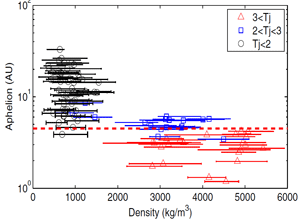- Details
- Published on 18 May 2011
Vol. 530In section 10. Planets and planetary systems
Bulk density of small meteoroids

Kikwaya et al. show that one can observe "shooting stars" (meteors) to infer statistically important information on both the small bodies (meteoroids) they came from and their parent bodies, ranging from asteroids to comets. The disintegration of meteoroids with milligram masses (similar to a small sand grain) in our atmosphere thus brings information on kilometer size parent bodies that may orbit many astronomical units away. Specifically, the authors analyze photometric observations of meteors to infer the orbital properties of the meteoroids in the Solar System and their density. As a result, they find that the average density of meteoroids whose orbits are asteroidal ranges from 2500 to 5500 kg m−3, probably related to a high-iron content population. Meteoroids with orbits belonging to Jupiter family comets have an average density of 3100±300 kg m−3. This high density is found for all meteoroids with JF-like orbits, which supports the notion that the refractory material reported from the Stardust measurements of 81P/Wild 2 dust is common among the broader JF population. Halley-type meteoroids have a bulk density value between about 250 to 1900 kg m−3. This is consistent with many previous works that suggest that bulk cometary meteoroid density is low.


